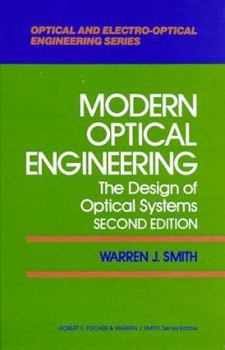Modern Optical Engineering: The Design of Optical Systems
Select Format
Select Condition 
Book Overview
Publisher's Note: Products purchased from Third Party sellers are not guaranteed by the publisher for quality, authenticity, or access to any online entitlements included with the product.The Latest... This description may be from another edition of this product.
Format:Hardcover
Language:English
ISBN:0070591741
ISBN13:9780070591745
Release Date:January 1990
Publisher:McGraw-Hill Companies
Length:524 Pages
Weight:2.00 lbs.
Dimensions:1.3" x 6.4" x 9.2"
Customer Reviews
5 ratings
This book is going to fall apart
Published by Sad , 3 years ago
The content is good. But the quality of the book is terrible. A big crack is emerging and there is the sound of breaking when turning pages.
Cook book without recipe?
Published by Thriftbooks.com User , 21 years ago
The Warren J. Smith book has been the only helpful book for me for above one year with the OSLO LT manual.It's not at all a formal text book. It's not at all a how to do for stupid people something book. It¡¯s not at all an look how I know so much of thing and you will never understand what I mean because I write a book only to impress people who can only look at my bibliography to hire me. Smith did not gave you an history course, an mathematic course, Smith really gave you advice when it¡¯s needed and some useful general formula you will never use but who give you some idea to create you own. Smith book is a multi level text. You read it once, and work a little, then you read it again and go back to try something...Smith approach helps you to understand how each problem you will meet will request a particular optical system.The best analogy to describe Smith book: ¡°A cook book without recipe, but advice to understand how to use you local potato to find yourself the best potato pie you can do with.¡±The section about ¡°the modulation transfert function¡± and the whole chapter 12: ¡°The design of Optical System: General¡± have been particularly useful for me.The only missing thing in the first edition I have consulted was absence of in book return (synergy) and the lack of formal presentation (for the optical prescription, notably). For example when Smith speak about merit function I say: "You will have to decide yourself of what is a good merit function and it's not really easy at all, it¡¯s the most difficult thing in that job¡", So I would have find some example an example of merit function in the end chapter about design 12, 13 and 14! It's a lack of return within the book. With the messy graphical presentation in chapter 13 and 14, it the only critic I have against Smith book who provide otherwise good understandable and ingenious graph combination to made simple the basic optical plot used in lens design.
Great Book for People New to Optics
Published by Thriftbooks.com User , 21 years ago
This book is an excellent source for technical people (a.k.a. engineers) who do not know much about optics but want to enter the field. Warren Smith discussed in great detail a plethora of subjects: how lenses & prisms affect light; how lenses can vary from ideal (a.k.a. first order optics) conditions and how to compensate their aberrations; how to use lenses, prisms, and mirrors in an optical system.I gave this book four stars out of five because I was expecting the CD to have free optical software with which I could play around with. The CD is great if you want to read the book off of your computer or share it with a friend, but it has no exercises to reinforce (a.k.a. to "learn by doing") the material the book covers.
The best survey of optical engineering
Published by Thriftbooks.com User , 23 years ago
Without doubt, this is the best general survey of optical engineering, in or out of print. The book shows both the author's broad experience as well as his ability to apply theory to practice. The book is far superior in its selection of topics and in clarity and accuracy of presentation to the alternatives, particularly Shannon's book. The book is useful for engineers or scientists from other fields who need to learn some optics, and for experienced practitioners who need a reference and refresher on particular topics. For example, try to calculate the spectral radiance of a blackbody at a particular wavelength and temperature using the formula in your college physics text, then see how Smith treats the same topic; if you got within an order of magnitude of Smith's correct answer from the college text, give yourself a gold star. The second edition's only weakness was its sparse references; I haven't seen the third edition so this may have been improved. However, this still puts Smith's book ahead of Shannon's, which has no references whatever. If you only buy one book on optics, this should be it.
Right choice
Published by Thriftbooks.com User , 24 years ago
The book is probably the best general text on optical engineering. It is written simle and clear. "Modern Optical Engineering" covers basic topics quite comprehensive. On the other hand, additional books are needed for good understanding of aberrations and a lens design procedure.






